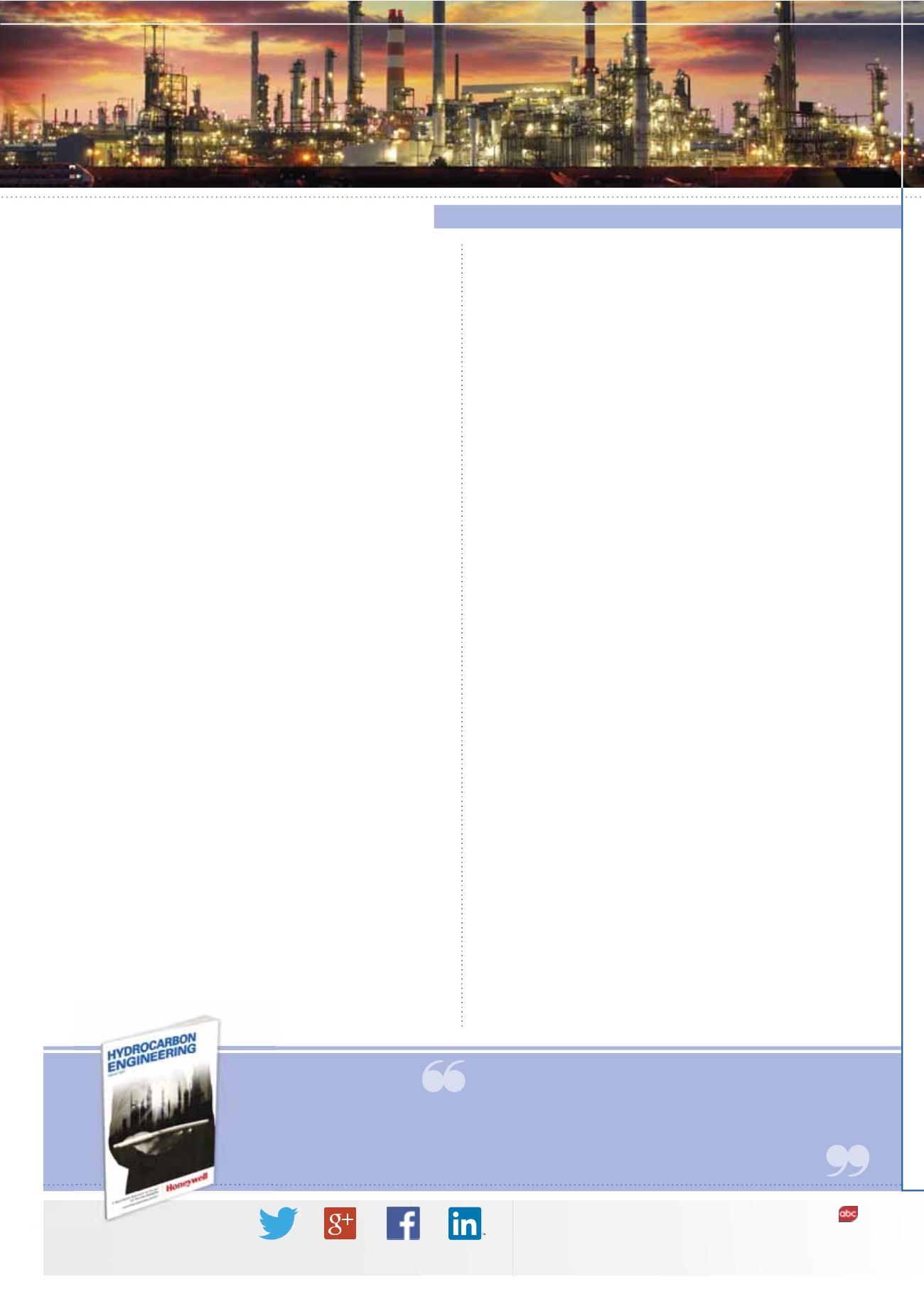
Copyright
©
Palladian Publications Ltd 2017.All rights reserved.Nopartof thispublicationmaybe reproduced, stored in a retrieval
system,or transmitted in any formorby anymeans, electronic,mechanical,photocopying, recordingorotherwise,without the
priorpermissionof the copyrightowner.All views expressed in this journal are thoseof the respective contributors and arenot
necessarily theopinionsof thepublisher,neitherdo thepublishers endorse anyof the claimsmade in the articlesor the
advertisements. Printed in theUK.Uncaptioned
imagescourtesyofwww.shutterstock.com.
2017 Member of ABCAudit Bureau of Circulations
CONTENTS
JOIN THE
CONVERSATION
THIS
MONTH'S
FRONT
COVER
March 2017
Volume 22 Number 03
ISSN 1468-9340
@HydrocarbonEng
follow
Hydrocarbon
Engineering
like
Hydrocarbon
Engineering
connect
join
Hydrocarbon
Engineering
03
Comment
05
World News
12
US refinery crude supply
As the global oil market moves into closer balance between supply and
demand, Contributing Editor, Nancy Yamaguchi, examines the possible
implications for the US downstream sector.
26
Looking to a prosperous future
Süleyman Özmen, Shell Global Solutions US Inc., USA, outlines the
importance of continuous improvement in refinery operations as a route to
sustained profitability.
34
Preparing for the IIoT evolution
Bart Winters and Francois Leclerc, Honeywell Process Solutions, present a
real-world approach to the Industrial Internet of Things (IIoT) for process
reliability.
41
Stable stacking
James Esteban and Wes Whitecotton, Criterion Catalysts & Technologies, USA,
discuss how stacked catalyst systems can improve catalyst system stability
and cycle longevity.
47
Is the catalyst enough?
Ken Chlapik, Scott Vidrine and Sravan Pappu, Johnson Matthey Process
Technologies, USA, and Paul Diddams, Johnson Matthey Process Technologies,
Europe, evaluate catalytic technologies and monitoring techniques that
enable reliable yet flexible refining operations between major turnarounds.
53
Making a breakthrough
Ray Fletcher, InovaCat B.V., the Netherlands, presents a new technology
capable of converting low valued naphthas into maximum propylene and BTX.
57
A versatile alkylation route
Mitrajit Mukherjee, Grace Brock, Vamsi Vadhri and Tom Hickey, Exelus Inc.,
USA, present a new process that converts butanes and methanol to alkylate,
resulting in minimal aromatics, olefins and sulfur content.
63
Controlling naphthenic acid corrosion
Sam Lordo, Dr. Kailash Sawhney, Dr. Satheesh Kumar Sambandam and
M. Rajganesh, Nalco Champion; An Ecolab Company, USA, provide an
overview of the use of phosphate ester inhibitors for controlling high
temperature naphthenic acid corrosion.
67
Joined-up thinking
Damage as a result of hidden corrosion is a major issue for the oil and gas
industry. Archie Crawford, Bilfinger Salamis, UK, looks at recent advances to
tackle the issue on offshore assets and asks whether there is something to
learn for those who maintain downstream facilities.
71
Measure it, manage it
Bruce Pellegrino, Sensor Networks, Inc., USA and Mike Nugent, E
2
G, USA,
examine a new technology for online corrosion monitoring and control when
processing opportunity crudes.
75
A flexible diet
Ralph Navarrete and George Duggan, Baker Hughes Inc., USA, explain how
desalter pH management can help to increase crude diet flexibility.
81
The cure to separation anxiety
Victor Scalco, General Atomics, USA, explains how fines control in the
catalytic process can help to increase profits from the 'bottom of the barrel'.
85
Lessons learned
Jimell Erwin, Ph.D., Southwest Research Institute, USA, outlines how
pilot-scale testing can help to assess the rewards and challenges of bioderived
feedstocks.
88
Important innovations
Duncan Baillie, LUX Assure Ltd, UK, explains how innovative technologies are
redefining chemical testing in the oil and gas industry.
93
A process revolution
Eugen Schibli, Mettler Toledo, Switzerland, explains how intelligent weighing
sensors with predictive maintenance can help the downstream processing
industry to stay ahead of issues and avoid disruptions.
97
Verifying viscosity
Luc K. Bellière and Philippe Burg, Sofraser, France, evaluate a new kinematic
viscosity analyser working at reference temperature.
101
Safe and sound
Ton Beems, Yokogawa Europe, the Netherlands, explains how compliance
with IEC-61508 and IEC-61511 standards can be ensured through the
operational phase of the safety lifecycle.
106
Sharing is caring
Allan Ralston, Safehouse, UK, examines how sharing innovation can help to
drive improved health and safety standards and performance in the oil and
gas industry.
113
The fatal four
Blast rated modules are often the last line of defense for those working
in blast zones. Gert Lessing, Hallwood Modular Buildings, USA, outlines
important safety considerations when selecting a module.
116
A helping hand
Hasan Alaradi, RRC Middle East, Bahrain, reviews a turnaround carried
out at ORPIC's Sohar refinery in Oman, focusing on the health and safety
requirements of the project.
123
Relieve the pressure
Stefan Rüsenberg, Rembe GmbH Safety + Control, Germany, discusses
failure analysis of high pressure rupture discs and presents effective counter
measures.
131
Use it or lose it
James Au and David Ng, Chemical Engineering Partners, USA, examine
various re-refining and recycling processes that can be undertaken to reduce
contaminants and preserve the value and usability of used oil.
137
Laser spectacular
Colin Pittman, Advanced 3D Laser Solutions Ltd, UK, examines the use of
laser scanning technology in the downstream storage industry, and how
it aids in high accuracy tank calibration.
141
Bringing the heat
Erika Ahvenainen, Intergraph®PP&M, the Netherlands, and Jana Miller,
Intergraph CADWorx®& Analysis Solutions, USA, outline how to improve heat
exchanger and pressure vessel design and analysis.
145
Heat technology Q&A
Hydrocarbon Engineering
questions a number of downstream heat technology
experts about R&D, testing and design, efficiency improvements and the
overall market outlook.
156
15 facts on...
This month we give you 15 facts on crude oil!
Honeywell Process Solutions (HPS) is a global leader with over 40 years
of experience delivering process automation and control solutions
that help industrial customers run their operations safely, reliably,
efficiently and sustainably through innovative technologies, services
and domain expertise. Withmore than 12 000 employees around
the world, HPS serves customers inmore than 125 countries in the
oil & gas, refining, petrochemicals, pulp & paper, specialty chemicals,
pharmaceuticals, industrial power, andmining &minerals industries.








